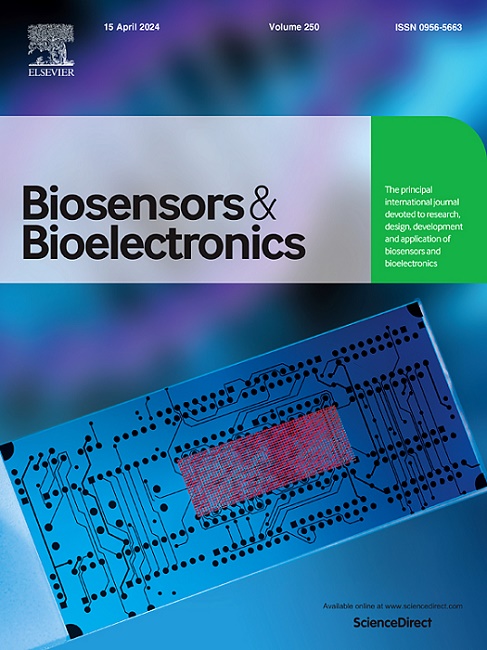Flexible microfluidics-integrated electrochemical system for detection of tumor necrosis factor-alpha under continuous flow of sweat
IF 10.7
1区 生物学
Q1 BIOPHYSICS
引用次数: 0
Abstract
Cytokines play a vital role in immune system signaling, making their detection crucial for continuous health monitoring. Among the various cytokines, tumor necrosis factor-alpha (TNF-α) stands out as a key regulator of the immune response. Notably, TNF-α can be detected in sweat at concentrations as low as pg/mL, with levels strongly correlated with those in blood. Despite its importance, sensitive, wearable, and continuous monitoring of TNF-α in sweat remains limited. To address this gap, this study presents a flexible electrochemical sensor integrated into a microfluidic system for the sensitive and selective detection of TNF-α under continuous sweat flow. First, we present the fabrication of two distinct, miniaturized designs of flexible screen-printed carbon three-electrode platforms, which are subsequently biofunctionalized with gold nanoparticles (AuNPs) coated with TNF-α-specific thiolated aptamers. Next, we compare the two geometrically distinct AuNP-aptamer-functionalized sensors, utilizing experimental and novel simulation-based characterization techniques. Finally, the sensors are integrated into a custom-built microfluidic system enabling the detection of TNF-α ranging from 0.2 to 1000 pg/mL under constant artificial sweat flow conditions, exhibiting high selectivity with negligible responses to non-specific analytes. These findings highlight the feasibility of integrating wearable cytokine sensors for detecting TNF-α under continuous sweat flow conditions, achieving clinically relevant sensitivity within the pg/mL range.
柔性微流体集成电化学系统在连续汗液下检测肿瘤坏死因子
细胞因子在免疫系统信号传导中起着至关重要的作用,因此检测它们对于持续的健康监测至关重要。在各种细胞因子中,肿瘤坏死因子-α (tumor necrosis factor -α, TNF-α)是免疫应答的关键调节因子。值得注意的是,TNF-α可以在汗液中检测到低至pg/mL的浓度,其水平与血液中的浓度密切相关。尽管其重要性,敏感的、可穿戴的、连续监测汗液中的TNF-α仍然是有限的。为了解决这一问题,本研究提出了一种集成在微流体系统中的柔性电化学传感器,用于连续汗液流下TNF-α的敏感和选择性检测。首先,我们提出了两种不同的、小型化设计的柔性丝网印刷碳三电极平台的制造,随后用涂有TNF-α-特异性硫代适配体的金纳米颗粒(AuNPs)进行生物功能化。接下来,我们利用实验和新颖的基于仿真的表征技术,比较了两种几何上不同的aunp适配体功能化传感器。最后,传感器集成到定制的微流控系统中,能够在恒定的人工汗液流条件下检测0.2至1000 pg/mL的TNF-α,具有高选择性,对非特异性分析物的响应可以忽略不计。这些发现强调了集成可穿戴细胞因子传感器在连续汗液流动条件下检测TNF-α的可行性,实现了pg/mL范围内的临床相关灵敏度。
本文章由计算机程序翻译,如有差异,请以英文原文为准。
求助全文
约1分钟内获得全文
求助全文
来源期刊

Biosensors and Bioelectronics
工程技术-电化学
CiteScore
20.80
自引率
7.10%
发文量
1006
审稿时长
29 days
期刊介绍:
Biosensors & Bioelectronics, along with its open access companion journal Biosensors & Bioelectronics: X, is the leading international publication in the field of biosensors and bioelectronics. It covers research, design, development, and application of biosensors, which are analytical devices incorporating biological materials with physicochemical transducers. These devices, including sensors, DNA chips, electronic noses, and lab-on-a-chip, produce digital signals proportional to specific analytes. Examples include immunosensors and enzyme-based biosensors, applied in various fields such as medicine, environmental monitoring, and food industry. The journal also focuses on molecular and supramolecular structures for enhancing device performance.
 求助内容:
求助内容: 应助结果提醒方式:
应助结果提醒方式:


